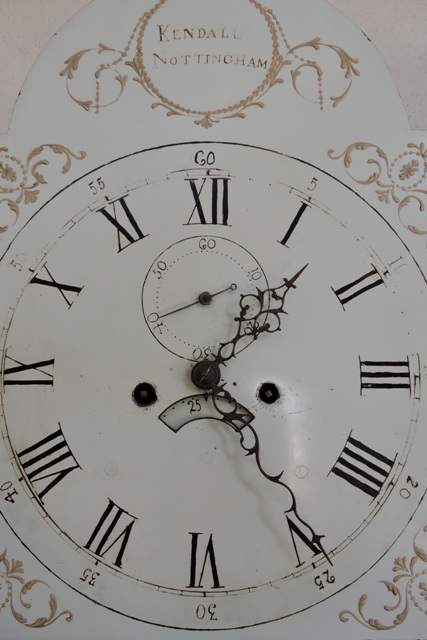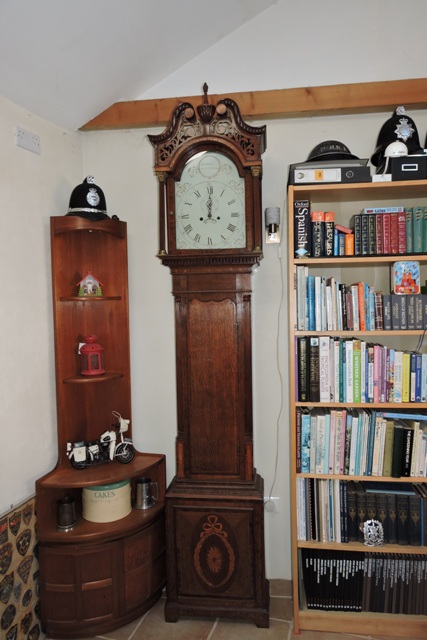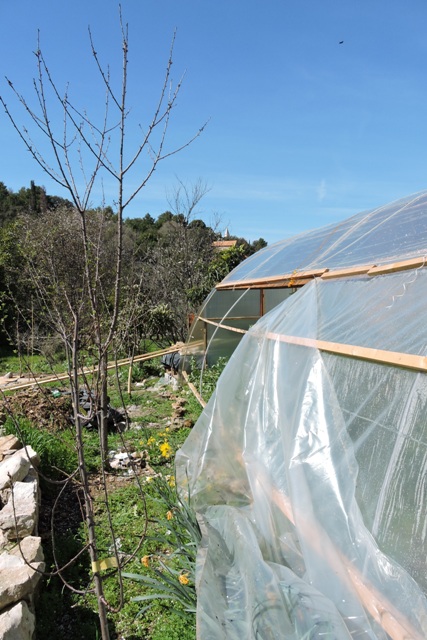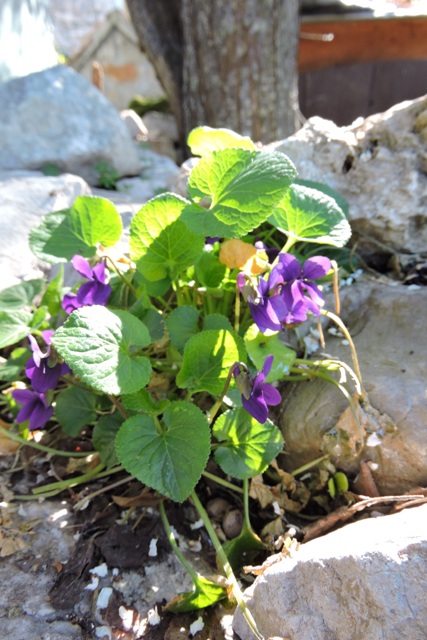It’s only a matter of time
This week: Turning words into deeds; Starting the clock; It’s only a matter of time; Attaching the top box; Changing covers; Flowers of the week;

What started as a “quick” job, rapidly turned into a three day event this week, but more about all that later.
I had to go over to Grad Hvar on Thursday. I was trying once again to check on progress of my planning application. In short there has not been any.
At the government office which deals with planning approval, they couldn’t even find my application.
So it is back to the architect once again to try and find what is going on. How absolutely typical for here!
The island is at it’s most beautiful on late spring days, when the sun is shining from a gin clear sky and the blue Adriatic is difficult to describe.
I came back along the old road which climbs out of Hvar and then follows the central ridge of the island, before a branch drops down to Stari Grad.
Over the winter the municipality has widened parts of this old road. It used to be a track for horses and mules and later became little more than a single track road.
In 2023, they have clearly had some heavy machinery in to break up the bed rock of the island which lined the narrowest parts of the road, to make it a two lane road, but only in places.
It was a nice run back to home though.
We have had our first 20ºC days of the year this week. With the warming days, so more of our avian summer visitors have arrived.
The first of the Scops Owls are back, calling at night from the Maquis behind my home.
From the first light of dawn, the nightingales are singing.
Stopping for coffee, there are usually three or even four birds singing and calling, hoping to attract a mate.
Overhead the Swallows are swooping and twittering as they head north.
There will now be a headlong rush towards mid-summer, which as the northern Vernal Equinox was passed this week, is just three months hence.
Turning words into deeds
I had an outside work plan for Monday, however when I awoke and saw it was cloudy, but with sunny periods, I decided to move the dining room furniture around instead.
The problem as I described last week, is bright sun streaming through a Velux roof window and onto everything underneath.
Dol is 42º of latitude north, so the sun in summer is close to vertical at mid-day. In winter it is barely above the trees behind my home.
As the earth orbits the sun, so the sun is constantly shifting its position in the sky.
I’ve noticed that the covers of books which were in the line of sunlight have all faded and I didn’t want my old Grandfather clock, with its inlaid marquetry suffering the same fate.
I lifted the door off its hinges to make moving things outside easier, and then cleared a bookcase to make some working space.
Behind a bookcase I found a damp patch on the outside wall, around a corner,. This meant a change of configuration plans.

I know the cause, but can’t do much about it until I have planning permission.
It’s a year since my last “spring clean”, so I set about dusting everything and polishing the wooden shelves.

After a full ten hours work, I called it a day.
With four bookcases moved, a corner unit and the clock case now in it’s new home, I had good progress to show for my efforts.
Starting the clock
Work continued on Tuesday to remove the detritus of the winter. I know that wood stoves are not the cleanest of heating appliances, but the nearer books are to the stove, the dustier they are.
With all the books back in place, my attention turned to the empty long case clock.
This is a family heirloom. I vividly remember it ticking away in the corner of the dining room of my Grandmothers home at Guiseley.
From there it has had two moves to my parents home’s in and near York, followed by its most recent move to Dol.
My Dad always looked after the clocks – he had a small collection – and I now wish I had taken more interest in them, when I had the chance.
This particular long case clock, according to family history, belonged to my Great Grandfather, one Richard Jennison.
In my family tree I know he was born in 1850 and died on 10th February 1919. He was part of the family which created Belle View Zoo in Manchester.
I have tinkered with clocks before, but have never peered deeply into the workings of this type of clock, often called simply a “Grandfather Clock”.
Removing the movement from the packing it came in from the UK, it was easy to fix it in place on the top of the case.

Next I opened the box of weights and attached them to the pulleys which were now in the body of the case.
Lastly, I opened the pendulum packing and attached it to the mechanism.
However when I tried to get the pendulum to swing and it did three or four “tick – tocks”, before stopping.
I have a reference book about long case clocks, but it didn’t really help much, so I turned to the internet.
Almost every website says that the clock mechanism must be perfectly level, both horizontally and laterally for it to work. So out came one of my small spirit levels.
Laterally it was spot on, but the case was leaning backwards.
A concern I have, especially with something as old and valuable as this, is that if or when we have a big earthquake, it will wobble and fall.
I have personal experience of a large earthquake in California and know what happens when the earth shakes!
So with this in mind and using one of the holes already present in the back of the case, I fixed the case to the wall.
It was still on all four feet, but was now held so it would not move, but had developed a rearwards lean.
Loosening the screw, I added shims under the two rear feet until the the case was level in all directions.
I tried starting the pendulum again.
But once again, after just a few “tick tocks”, the pendulum stopped.
It’s only a matter of time
I don’t know when the clock last worked, but it was more than ten years ago, so I decided that I had better remove the motion, have a good look in sunlight to see if anything was amiss and try a little lubrication.
I found that there is a name cast into the back plate. It is stamped “Osborne”.

After a bit more on-line work and I discovered that “Osborne” is a well known Birmingham based maker of clock dials.
Thomas Osborne was in partnership with James Wilson from 1772 until 1777 when the partnership was dissolved. The company continued making dials until around 1813 and the company was also run by his widow Ann and his son James.
This seemed to make the clock much older than my family history suggests.
After some more digging, looking at things like the design of the clock’s hands, the actual mechanism and the face plate, it seems to date from 1780 to 1810 time period.
But it was lunch time, so I stopped for a break. A bright sun in a clear sky was reflecting off the newly cleaned and polished floor, lighting up the room.
The case door was open and with the pendulum, weights, pulleys and cables removed it was completely empty. As I walked past, I saw writing in pencil on the wooden back of the case, illuminated by the light being reflected up off the floor.

Clearly visible was “Repaired 1811”. Followed by a later comment “Repaired August 1949 BRJ”. Brian Richard Jennison was my uncle.
The first pencil marking is intriguing through. It looks like the initials AS followed by 82.
Could this be the maker, in the ear 1782? It would certainly fit with the other circumstantial evidence of the age of the movement, face and hands.
Whatever, it means that the clock has been in the family much longer than the three generations I thought.
Thomas Osborne sold his movements and faces to cabinet makers, who then built the case for the clock. So the name on the face of “Kendall Nottingham”, would have been the cabinet maker.
There is no trace of him on the internet.

I went back to cleaning the movement. I removed some dried oil, gingerly cleaned teeth on the various gear wheels and applied a very light modern oil, mixed with PTFE, to the various spindles and bearings.

Putting everything back together, I was able to start the crutch lever without the heavy pendulum attached.
After two or three slow starts, I was able to get the full movement working, but running at six times normal speed. So the clock recorded six hours of time for every hour it ran.

After several hours of fast running and some more light lubrication, I attached the pendulum and the clock ran.
It was a little fast, gaining three seconds an hour, but it ran for 24 hours without a fault.
Attaching the top box
With everything working it was time to fix the face onto the mechanism.
When I removed the face at the start of the project, it was held by three bits of thin, bent wire, so these needed to be replaced.
I have some of my Grandfathers engineering tools, so it seemed entirely appropriate that I used his calliper gauge to measure the thickness of the wire.
This is so I can replace the bits of bent wire with brass pins.

With the face securly attached to the mechanism, it was time to replace the top cover.
The top cover is also made of heavy Mahogany and has an old glass front door.
I carefully cleaned the glass and then polished it, also polishing the wooden surround. from the floor to the top finial, the clock is 2.6 meters tall.
When I slid the top box over the case, I realised that it was only gravity which held it in place, so I removed it again.
I don’t have any spare bits of Mahogany lying around unfortunately, so I fabricated two swivels from softwood, which will hold the top box to the rest of the case.
What I do have is a supply of brass clotted head screws, so used a couple of these old style of screws to fix the swivels to the top box.

Knowing that the clock in Europe go forward an hour tonight, at the start of “summer time”, I set the clock an hour ahead of the actual time. I also made a small adjustment of the pendulum to correct the fast running.
Finally I slid the top cover into place and turned the locking swivels.

So what is in all probability a 240 year old timepiece, is once again keeping good time, still in the family of the original owner.
Changing covers
As the daily temperature climbs and passes the 20ºC mark in the shade, according to my digital thermometer, so in the polytunnel, the temperature has been increasing too.
Since the 6th March, the maximum daily temperature inside has been between 36ºC and 38ºC, even with the door open and the roof vented.
The bananas, guava and pineapples like the het and high humidity, but by mid summer, at that rate the temperature would be over 50ºC.

I had always planned on removing the clear plastic around the bottom ⅓ of the polytunnel, so this week seemed like a good time.

The plastic film will have to be replaced again in the late autumn, so I have devised a way to quickly change the covers.
I’ve ordered stainless steel butterfly nuts, washers and 90mm coach bolts from AliExpress. They all arrived at the end of February.
My idea is that the coach bolts will go through the wooden battens from the inside and the butterfly nuts and washers will be on the outside.
This is why I wanted to use just stainless steel fittings, so they will not be affected by corrosion. The outside batten will secure the plastic film, but it can easily be removed for the biannual seasonal change.
I’ve done the work this week in two halves, but it has taken some time. First I had to remove the clear plastic film and roll it up, ready for reattaching.

The shade netting I have purchased for the summer has rings along the edges, so I have had to match the coach bolts to the location of the rings in the material.
I’ve bought expensive shade netting so it will not degrade in the strong summer sun here in Dol. This week we are receiving 562 watts /m² and the UVI index is 5. It is the Ultra Violet light which rots plastic.

This project is another example of doings things once and doing them right. There are fifty coach bolts and they will be easier to use than screws.

So although I’ve spent the best part of two days on the project, I know that come the autumn, it will be a much shorter job to add the plastic back on.
I think I will probably leave the shade netting in place over the winter too, as added insulation.

Flowers of the week
With the lengthening and warming days, so we are rapidly advancing through spring to early summer.
Almost every day, I see more buds have burst, new leaves have appeared and flowers have opened.
I have several water filled tubs containing pond plants and water lilies. They are all waiting for their home in an ornamental pond to be built.
The Marsh Marigold flowers have started to open this week.

Yellow is a colour of spring time. I have two shrubs, side by side in one of my flower borders. The Forsythia Intermedia is at its best this week.
Soon the flowers will fade and the bright green leaves will appear.

Next to it is my Kerria japonica, Batchelors Button. It is not as far advanced as the Forsythia, but the two compliment each other.

In a pot I have a Magnolia Stellata, but it is not very happy. I suspect that it is pot bound and I need to put it into a border.

Also looking absolutely beautiful this week are some Daisy Anemone. The Anemone is a Mediterranean native, but these with all their gorgeous lilac petals are a hybrid.

Over winter I have had perennial Violets, Viola, in flower in a rock wall. Then when we had some slight frost at the start of February, all their leaves were burnt.
As the weather warms, hey have grown new leaves and are in flower once again.

For me, spring is always a magical time of year. NCG